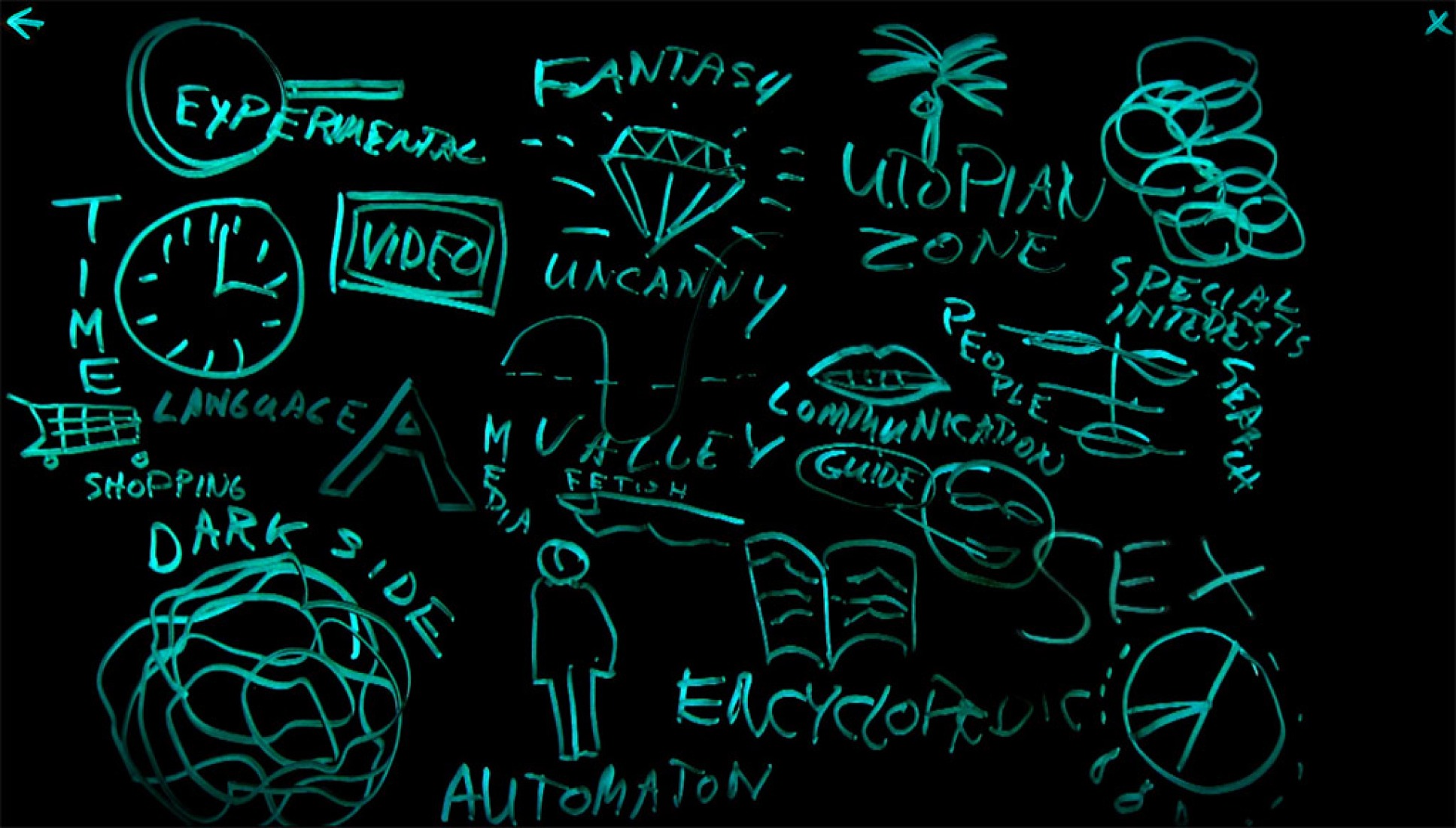Numbers scroll on a screen. Ethereal music fills the air. Cityscapes flash by. New York. Hong Kong. Venice. San Francisco. Streets and skylines are dipped in golden sunlight. But something is different. From the heart of each metropolis arises the same futuristic skyscraper. Its three shimmering towers are locked in a helical embrace. Its milky, undulating forms sprang from the imagination of Italian architect Filippo Innocenti, a Zaha Hadid associate.
Welcome to the Adobe Museum of Digital Media (AMDM). Located nowhere and everywhere, it opened in October on the web (adobemuseum.com). It has a curator, Tom Eccles, and an inaugural exhibition by Tony Oursler. It even has a “personal viewing pod”, a one-eyed fish in a soap bubble that flaps about like a Pixar character. “For the artist’s biography, click the museum directory,” she says, in a vaguely French accent that invokes Simon de Pury’s mellifluous auction chant.
Is this the digital future of the museum? Don’t count on it. The AMDM is a mesmerising virtual ride but it bears little resemblance to how museums are using digital tools, or to what lies ahead once they fully embrace new media.
1.0.
With few exceptions, museums came late to the digital party. Until quite recently, most have used their websites as extended online brochures, limited to practical information and collection highlights. Digitising and sharing the breadth of a museum’s collection is a costly, time-consuming and complicated endeavour (especially for contemporary art, where copyright restrictions are in effect). As for videos, apps, social media and all things wiki—such bells and whistles have only just started popping up on museum sites.
But in fairness, museums are further along on their new-media projects than other kinds of fine-art institutions. And they are more digitally dexterous than most commercial galleries. “The art world is constitutionally reluctant to commit to a real digital presence, whatever the platform,” says Kevin Conley, a former New Yorker writer who created The Exhibitionist mobile app for gallery-goers, “because so much of the value in the art business is based on the control of information.” Meagre budgets and a vogue for minimalist design contribute to a dull uniformity in the promotion of art online.
There are glimpses of promising innovation around the art world, of course. Lehmann Maupin Gallery’s website features elegant videos showcasing artists and exhibitions (lehmannmaupin.com). Jen Bekman’s 20x200 project (20x200.com) has shown that online gallery sales can be successful. Pace Gallery, in addition to its content-rich website and archive, is publishing digital catalogues raisonnés through its Artifex Press (artifexpress.com). Intrepid dealers like Ed Winkleman are well known as bloggers (edwardwinkleman.com). Auction houses are uploading catalogues, videos and viewing tools that help clients examine and bid—some are even tweeting their sales. Art Basel’s 3D smartphone app, launched last June, has solved the vexing problem of finding a gallery booth or a midday sandwich (artbasel.com/go/id/lre). There’s even an online art fair (vipartfair.com), coming in January to a device near you.
Museums are watching these developments closely. They know that they too must conquer new media and respond to the changing habits of their audiences, or risk losing their relevancy. But art museums are, by design, conservative. They are understandably anxious about investing in technology that could become obsolete. And they don’t want to be seen jumping on bandwagons. Mastering the digital future takes time, resources and a willingness to test comfort zones, even for the most open-minded institutions.
2.0.
Despite these obstacles, the most widely recognised museum innovators—MoMA, Indianapolis Museum of Art, Walker Art Center, Brooklyn Museum, Tate, Los Angeles County Museum of Art, to name a few—have been steadily expanding their digital footprints. Dramatic changes have happened in the past 18 months. Major upgrades are in the works at the Metropolitan Museum and other bellwether institutions. Progress is accelerating.
First, technology is changing the relationship between objects, curators and visitors. The linchpin is collection searching, which has improved by an order of magnitude in recent years. The Victoria and Albert Museum’s jam-packed site (collections.vam.ac.uk), which can search a million objects with the help of an intuitive user interface, is a prime example. (Advances in so-called semantic data, which analyse the kind of complex queries that arise in humanities research, mean that even more sophisticated searches may be around the corner.) Digital tools are letting visitors experience objects in new ways. On the Louvre’s site, visitors can zoom in on masterpieces and tour virtual galleries (louvre.fr). Some museums, including MoMA, now invite visitors to curate their own art selections with an “add to my collection” button. As for that time-honoured delivery mechanism for curatorial research, the catalogue, experts predict a wholesale shift to electronic publishing within five years.
Second, much of this innovation is being spurred by an explosion in usage of mobile media. Museums are developing mobile versions of their websites for smartphones and tablets. They are migrating from Acoustigides to cheaper, more flexible cellphone technology, which they can customise in clever ways. At the Brooklyn Museum visitors can play “gallery tag”, finding works with certain attributes and entering their accession numbers via cellphone to earn points and prizes (brooklynmuseum.org). Not a week passes, of course, without a fanfare about a newly launched museum app. These are still a work in progress. Some have less information than wall labels. But progress and economics are on their side.
Third, museums are venturing beyond traditional curatorial material. Their homepages are beginning to look like magazine sites, with channels for news, streaming content and audience dialogue. Blogs, written by staffers or professionals, routinely attract the most traffic on museum websites. Some institutions are experimenting with user-generated content. The National September 11 Memorial and Museum is collecting pictures and videos from witnesses and victims’ family members (makehistory. national911memorial.org). The V&A is asking for public input on how to crop 140,000 digitised photographs (collections.vam.ac.uk/ crowdsourcing). New distribution platforms, such as ArtBabble, a kind of YouTube for art videos from a consortium of institutions (artbabble.org), are putting museums in the communications business.
Fourth, technology is revitalising museum education. Digital media open up new pathways for exchange between experts and visitors, and are making it possible for members of the public to learn from each other. Digital initiatives can make learning fun. The Smithsonian American Art Museum’s multimedia scavenger hunt, “Ghost of a Chance”, in which players used text messages, email and the web to find hidden objects in the museum, drew 3,000 participants. A few museums are even dipping their toes into online education. MoMA’s education portal lists 20 courses aimed at the general audience, starting at $220, with titles like “The 1960s: Art and Life” (www.moma.org/learn/courses/courses).
Fifth, the web is, of course, a marketing tool par excellence. Social media initiatives are blending education and marketing. An international web event last September called “Ask a Curator” made available experts from 340 museums for online questions (askacurator.com). It generated a lot of new visitors. The Guggenheim Museum’s creative video biennial, “YouTube Play”, a collaboration with YouTube, HP and Intel, attracted a staggering 23,000 submissions this autumn (youtube.com/play). From the Prado’s Google Earth tool, which zooms in from space on the collection’s most iconic paintings (google.com/intl/en/landing/prado), to Jeffrey Deitch’s personal tour of his Los Feliz home (moca.org/audio/blog/?p=988), museums are discovering ingenious ways to build audiences.
Last but not least, technology is transforming professional museum practice. The Museum Dashboard, developed at the Indianapolis Museum of Art, takes transparency to a new level by providing real-time information on everything from the size of the endowment to objects slated for deaccessioning (dashboard.imamuseum.org). Some of the least sexy but most significant improvements are happening behind the scenes, where digital tools are helping museums gather data about visitors, manage collections, and keep a handle on budgets and human resources.
3.0.
As they feel their way toward a digital future, museums need to think deeply about what they stand for: what are they willing to sacrifice for the sake of evolution, and where will they draw the line against technological disruption? There are crunchy practical dilemmas to solve: can museums recover the costs of their digital operations? How will they deal with copyright restrictions? What to do about privacy protections or unwanted commercial intrusion?
And there are the intangibles: what is the ideal balance between physical objects and virtual experience? Is the function of technology to turn the museum into more of a community space, or to facilitate encounters of a deeply personal kind? Should museum websites aspire to the frenzied hyper-realism of video games, or should they leave that kind of thing to purveyors of popular entertainment?
Privately, some directors and curators are anxious about unintended consequences. Many older visitors like their museums just as they are. There is something to be said, after all, about the museum as a gadget-free zone—a last bulwark against computerisation. A smartphone is a cool and quick way to find the great blue whale or The Garden of Earthly Delights, but what’s wrong with getting lost in a museum?
In any event, technological change hasn’t seeped yet all the way into museums’ innermost structures and attitudes. When it does, museums will look very different. Digital innovation doesn’t just enable institutions to do old things in new ways. It forces fundamental and often painful realignments. Just look at the news.
For art institutions of all stripes, embracing new media will mean “not just a lot of whiz-bang technology, but a rethinking of the relationship with the audience,” says Artsjournal.com founder Douglas McLennan. It means adopting a new approach to information across all departments. A decade ago, a museum’s IT department was a backwater. Today, it belongs next to the director’s office. The notion that technology is less of a tool and more of mindset doesn’t come naturally to experts steeped in object-oriented practice.
The hardest part may be letting go.
Museums have a long history of exercising total command over their content. That’s over. “Museums in the future will still be reliable sources of information, and a curator will continue to be the authority on a particular work of art,” says Rob Stein, chief information officer of the Indianapolis Museum of Art. “But we won’t control the information channels.”
"In recent years, major museums and art institutions have moved into the world of technology and have made great strides in adapting to the digital age, but they need to go much further to tailor their content to the new requirements visitors. "This is the position defended by András Szántó, associate editor of The Art Newspaper, in a recent article, Time to loose control (It's time to lose control), which, by their interest, we reproduce below:
More information
Published on:
January 15, 2011
Cite:
"Adobe Museum of Digital Media. AMDM" METALOCUS.
Accessed
<https://www.metalocus.es/en/news/adobe-museum-digital-media-amdm>
ISSN 1139-6415
Loading content ...
Loading content ...
Loading content ...
Loading content ...
Loading content ...
Loading content ...
Loading content ...
Loading content ...
Loading content ...
Loading content ...
Loading content ...
Loading content ...
Loading content ...
Loading content ...
Loading content ...
Loading content ...
Loading content ...
Loading content ...
Loading content ...
Loading content ...
Loading content ...
Loading content ...
Loading content ...
Loading content ...
Loading content ...
Loading content ...
Loading content ...
Loading content ...
Loading content ...
Loading content ...
Loading content ...
Loading content ...
Loading content ...
Loading content ...
Loading content ...
Loading content ...
Loading content ...
Loading content ...
Loading content ...
Loading content ...
Loading content ...
Loading content ...
Loading content ...
Loading content ...
Loading content ...
Loading content ...
Loading content ...
Loading content ...
Loading content ...
Loading content ...
Loading content ...
Loading content ...
Loading content ...
Loading content ...






















![Ivo Precek, Pracovní tabule II [Work table II], 1965. "From the center of Europe. Czech photography, 1912-1974". Image courtesy of Juan March Foundation Ivo Precek, Pracovní tabule II [Work table II], 1965. "From the center of Europe. Czech photography, 1912-1974". Image courtesy of Juan March Foundation](/sites/default/files/styles/mopis_home_news_category_slider_desktop/public/lead-images/metalocus_fundacionjuanmarch_fotografiacheca_precek-.-pracovni-tabule-ii-1965_p01.jpg?h=e382d23c&itok=PryOojGF)




